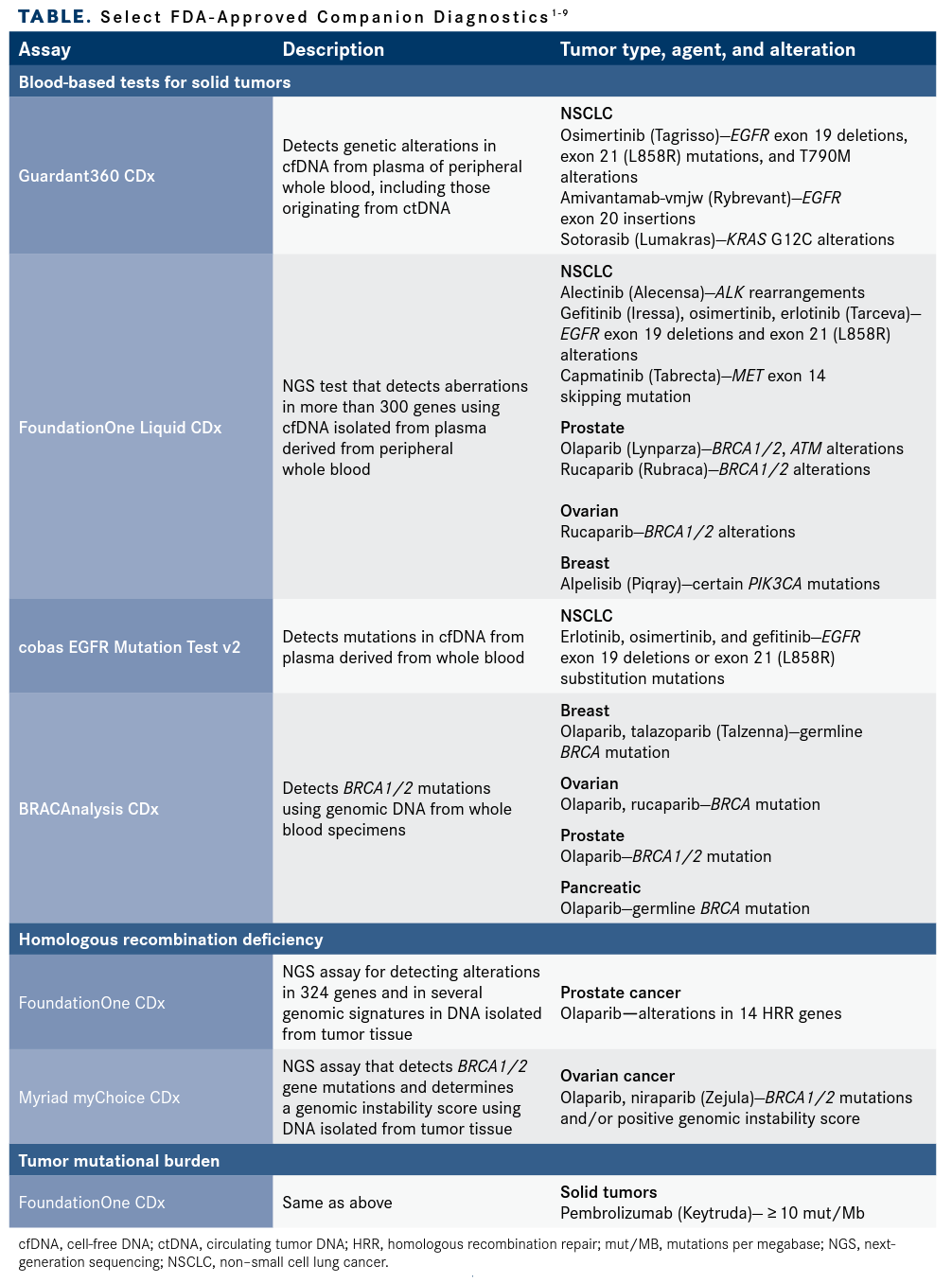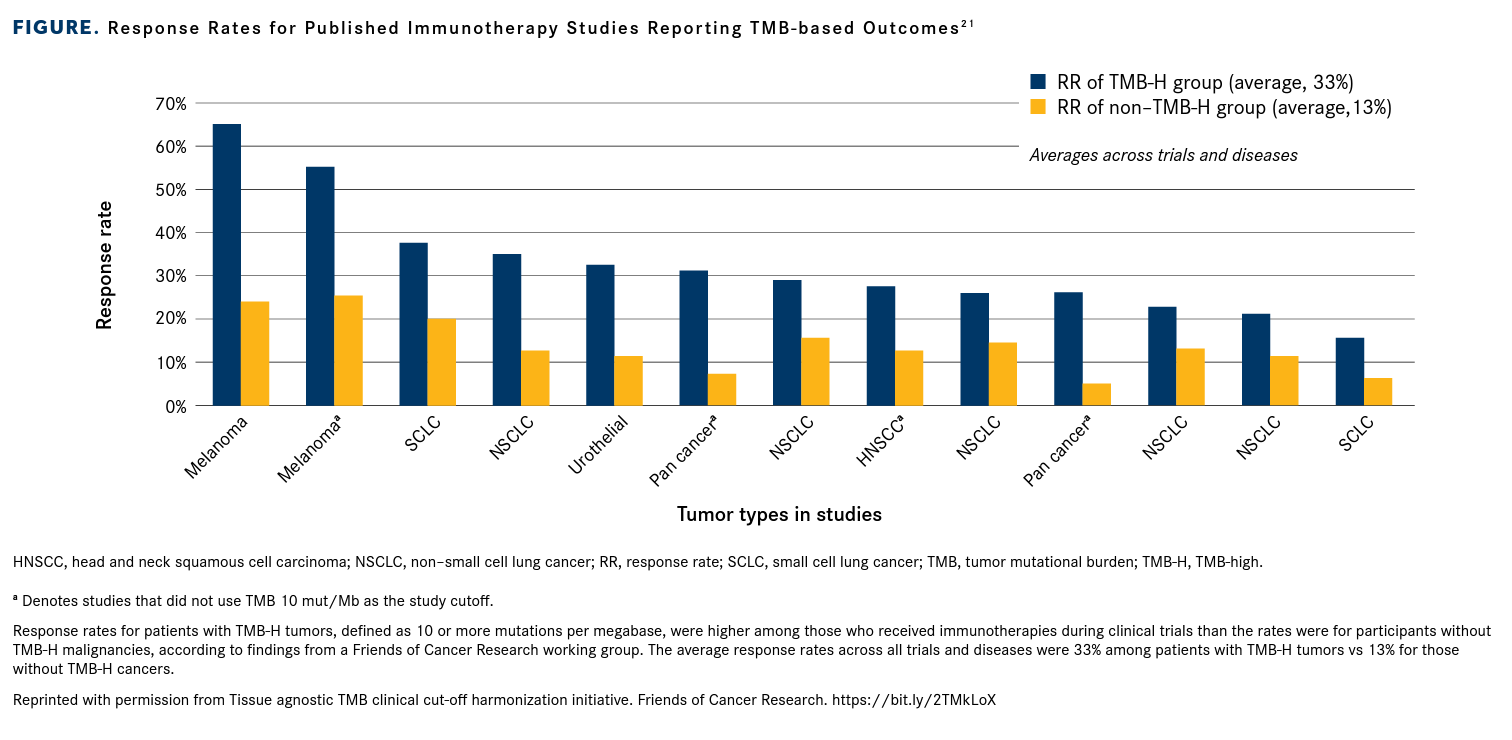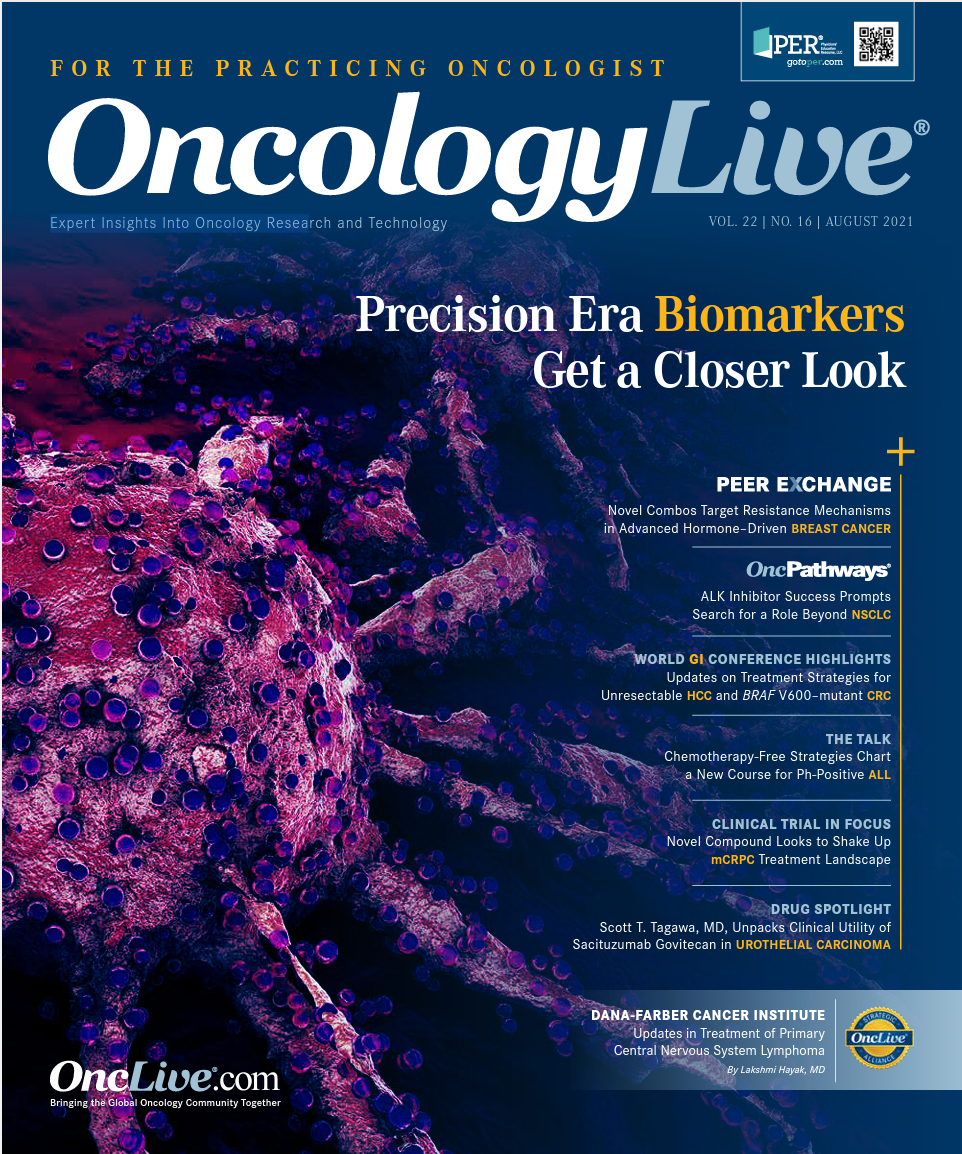Publication
Article
Oncology Live®
3 Precision Era Biomarkers Get a Closer Look
Author(s):
Circulating tumor DNA, tumor mutational burden, and homologous recombination deficiency are 3 emerging biomarkers for tailoring therapy need further clinical and technical clarity to support robust use in daily practice.
Mark Stewart, PhD

Although the precision medicine era is in full swing in oncology, 3 emerging biomarkers for tailoring therapy need further clinical and technical clarity to support robust use in daily practice, according to experts. Academic, government, and industry investigators are collaborating on projects intended to expand the understanding and ultimately the clinical utility of these markers: circulating tumor DNA (ctDNA), tumor mutational burden (TMB), and homologous recombination deficiency (HRD).
Friends of Cancer Research, an advocacy group that helped pioneer the breakthrough therapy program and other regulatory advances, has brought together teams of experts to explore each of the biomarkers. The goal of the ctDNA project is to demonstrate whether changes in levels of this biomarker can be used to signal the efficacy of therapeutic strategies in a range of solid tumor types, whereas the objective of the TMB and HRD programs is to answer questions about differences in assays that assess these genomic signatures.
The quest to better understand these biomarkers comes amid an increase in FDA approvals of oncology therapies for specific subsets of patients with cancer based on the presence of a measurable biological feature, including recent novel agents associated Mark Stewart, PhD with the markers under study, according to Mark Stewart, PhD, vice president of science policy at the Friends group (Table1-9). He also noted that there has been an “exponential” increase in the number of clinical trials that integrate ctDNA, TMB, or HRD testing into the study design.
Select FDA-Approved Companion Diagnostics1-9

For Friends, the research partnerships are intended to “leverage new technologies and help expedite drug development,” Stewart said in an interview with OncologyLive®. “They present an opportunity for us not only to contribute to improving our scientific understanding of these biomarkers in their application in clinical care in oncology and drug development but also...to help support that evidence for further use,” he said.
For practicing oncologists, the research may shed light on how best to use these biomarkers in therapeutic decision-making and, in the case of TMB and HRD, more sharply define the information that can be gleaned from different assays. “Developments over the past year and from the diagnostic market have really shown that these complex biomarkers are becoming increasingly used and important in oncology care,” Stewart said regarding TMB and HRD testing. “But with these complex biomarkers, we have to recognize that they’re complex for a reason.
“What we’re seeing is that there’s not necessarily 1 way to define these biomarkers and assess them,” he said. “It does create a scenario where results from one test may not be interchangeable with another test.”
Expanding the Utility of ctDNA Testing
ctDNA, defined as fragments derived from tumor cells undergoing apoptosis or necrosis,10 comprises a small fraction of circulating cell-free DNA (cfDNA) in the bloodstream of patients with cancer, with levels dependent on tumor burden, histologic type, and malignancy stage. Investigators have sought to leverage cfDNA for liquid biopsies in solid tumors, and its potential as a tumor biomarker was first identified in 1994.11
In 2016, the FDA approved the first liquid biopsy test, cobas EGFR Mutation Test v2, which is indicated for the detection of EGFR exon 19 deletions or exon 21 (L858R) substitution mutations in the plasma of patients with non–small cell lung cancer (NSCLC).12 The assay is now designated as a companion diagnostic for patients with NSCLC who are candidates for therapy with erlotinib (Tarceva), osimertinib (Tagrisso), and gefitinib (Iressa).1
Although several tumor-profiling assays that use next-generation sequencing (NGS) technology on plasma samples have since gained approvals, the use of ctDNA has been limited in clinical practice. The Friends’ ctDNA for Monitoring Treatment Response (ctMoniTR) Project is seeking to establish whether changes in ctDNA correlate with responses to therapy for a broad range of tumor types, thus expanding its potential.
In August 2020, the Friends group reported findings from its comparison of outcomes for pooled data involving 200 patients with advanced NSCLC treated with PD-1/PD-L1 immune checkpoint inhibitors whose ctDNA levels had been measured with 5 assays. The results showed that changes in ctDNA measurements of variant allele frequency (VAF) levels from baseline were associated with overall survival (OS), progression-free survival (PFS), and treatment response.13
The data demonstrated that VAF levels (strong increase, intermediate, and strong decrease) correlated with outcomes. Patients with a 50% or higher decrease in maxi-mum VAF from baseline during therapy had a stronger association with better OS (P < .0001) and PFS (P = .0002) than did those with an increase or weak decrease. A strong decrease in maximum VAF also correlated with improved rates of partial responses or better.13
In June 2021, Friends launched the next step of the ctMoniTR Project: collecting data from more than 25 studies involving over 3000 patients with diverse malignancies, including lung, melanoma, thyroid, breast, and head and neck cancers, who received treatment with a variety of therapies. Investigators will analyze the data to determine whether ctDNA can be used to identify whether patients are responding to treatment earlier than other methods of evaluation. Preliminary results are expected to be released in 2022.14
Matthew D. Hellmann, MD

The findings may help answer the question of whether responses to therapy can be monitored serially with a blood test, accord-ing to Matthew D. Hellmann, MD, a medical oncologist at Memorial Sloan Kettering Cancer Center in New York, New York, who is participating in the ctMoniTR Project.
Currently, ctDNA testing is used primarily for molecular profiling and genotyping of patients with known cancer, he noted. “This advance would expand the use of the ctDNA tests. The information from ctDNA dynamics would show not just whether there is a genetic alteration that can be targeted but what is happening in the patient in real-time, whether their cancer treatment is or isn’t working.”
Hellmann, a lung cancer specialist, has contributed to a growing body of evidence showing the clinical utility of ctDNA testing. In a pan-cancer analysis, Hellmann and colleagues studied ctDNA levels before and after therapy for patients treated with the PD-L1 inhibitor durvalumab (Imfinzi) in 3 clinical trials spanning 16 types of advanced cancers.15
Lower levels of pretreatment ctDNA were prognostically associated with improved OS among patients with the most prevalent cancer types in the study such as NSCLC (n = 333) and urothelial cancer (n = 226). And among a subset of patients with on-treatment ctDNA, a substantial decrease in ctDNA on-treatment significantly correlated with improved OS and PFS.15
In another report published in Cell in October 2020, colleagues from Stanford along with Hellmann described a model for a noninvasive assay incorporating pretreatment ctDNA with immune profiling for markers such as CD8 T cells and PD-L1 expression as well as early on-treatment ctDNA levels. The assay, DIREct-ON, accurately classified the likelihood of durable benefit for patients with NSCLC who received PD-L1 inhibitor therapy after 1 treatment cycle.16
Assays that measure ctDNA have the potential to help inform treatment across tumor types, Hellmann said. “I anticipate that this diagnostic tool will have broad relevance in clinical practice and research, including across the spectrum of cancer stages, from the earliest days to the latest stages, across the range of cancer types,” he said. “It could also expand across different types of treatments, from targeted treatment to chemotherapy to immunotherapy.”
For practicing oncologists to embrace such assays, clinical evidence would have to show that they are helpful in guiding clinical decision making, Hellmann said. “The first step is to prove that the information is useful—to show the clinical applicability of having the information on hand to be able to make treatment decisions,” he said. “Fundamentally, the primary goal of Friends of Cancer Research is to demonstrate that having an assessment of ctDNA during an early course of treatment would allow clinicians to have an early read on how patients are doing on the treatments they’re getting. That can be the foundation for wholly new paradigms for clinical treatment; you would know where there could be early transitions away from ineffective treatment or early addition of a new treatment. It could really change the way that we approach a given patient.”
More Clarity for Complex Biomarkers
When it comes to TMB and HRD, the Friends research teams are focused on helping to clarify the results of assays that have limited immediate clinical applications but are likely to be more frequently employed in cancer care in the future. “There’s a wide variation in how TMB and HRD are being defined, measured, and reported across these studies that are being published,” Stewart said. “This clearly highlights a lack of standardization and harmonization and how these markers are being used. As you could imagine, that can create scenarios where there might be confusion about how to appropriately use these tests, affecting their integration into clinical care.”
TMB
TMB, a measure of the number of somatic mutations per megabase (mut/Mb) of the tumor’s genome,17 currently is approved as a biomarker for 1 drug.3 In June 2020, the FDA granted an accelerated approval for the PD-1 inhibitor pembrolizumab (Keytruda) as treatment for adult and pediatric patients with unresectable or metastatic TMB-high (TMB-H) solid tumors (≥ 10 mut/Mb) that have progressed after prior therapy and who have no satisfactory alternative treatment options. The agency designated the FoundationOne CDx assay, which uses DNA isolated from formalin-fixed paraffin embedded tumor tissue specimens, as the companion diagnostic.18
The approval was based on findings from the KEYNOTE-158 trial (NCT02628067) involving 102 patients with TMB-H tumors spanning 9 cancer types who received pembrolizumab monotherapy at 200 mg every 3 weeks. Tumor types included small cell lung, cervical, endometrial, and anal cancers.
After a median follow-up of 11.1 months, the objective response rate among patients with tumors with a TMB of 10 or more mut/ Mb was 29% (95% CI, 21%-39%), including a 4% complete response rate.19
So far, the FoundationOne CDx assay is the only FDA-approved companion diagnostic for assessing TMB.1 The agency has also cleared the MSK-IMPACT assay for use as a tumor-profiling NGS test that can measure TMB.2,17 Meanwhile, a growing pipeline of commercial and laboratory-developed tests with different features may affect TMB estimations, according to a review by members of the TMB Harmonization Consortium that Friends organized. Differences in commercial and academic tests may include the numbers and types of genes, sequencing platforms, and bioinformatics protocols.17
During the past 3 years, the consortium has identified sources of variability in testing methods and agreed on the creation of a universal reference standard that reconciles data from whole-exome sequencing, which was initially used in TMB research, with scores generated by targeted panels.20
The group then evaluated retrospective clinical trial data involving more than 1700 patients with diverse tumor types who were treated with immune checkpoint inhibitors. Overall, patients with TMB of 10 mut/Mb or higher had average response rates of 33% vs 13% for those with lower scores (FIGURE21). Similar support for that definition of TMB-H was evident in a further analysis of response data for patients with scores in an “equivocal zone” between 10 and 15 mut/Mb.21
As data mature, the Friends group anticipates a need for further consideration of how diagnostic test approvals can include patients with scores in the equivocal zone.
Response Rates for Published Immunotherapy Studies Reporting TMB-Based Outcomes21

HRD
HRD is broadly defined as a defect in DNA repair mechanisms caused by loss of function in homologous recombination repair (HRR) genes, including those encoded by BRCA1, BRCA2, RAD51, RAD51C, RAD51D, and PALB2. In current clinical practice, the use of HRD testing has emerged as an important feature of selecting patients with ovarian cancer for PARP inhibitor therapy in certain settings.22
Olaparib (Lynparza) is approved in combination with bevacizumab (Avastin) as maintenance therapy for patients with HRD-positive advanced epithelial ovarian, fallopian tube, or primary peritoneal cancer who have responded to first-line platinum-based chemotherapy.23 Niraparib (Zejula) is indicated for patients with HRD-positive advanced ovarian, fallopian tube, or primary peritoneal cancer whose disease has progressed after 3 or more prior chemotherapy regimens.24 Both drugs carry additional indications that do not require HRD testing.
For both therapies, HRD status is defined as a deleterious BRCA mutation or genomic instability, as measured with the Myriad myChoice CDx assay, which generates an algorithmic measurement of loss of heterozygosity, telomeric allelic imbalance, and large-scale state transitions using DNA isolated from tumor tissue.23,24
As with TMB, the clinical applicability of HRD assessment is expected to grow as research continues. HRD can be defined in multiple ways, according to a working group that the European Society for Medical Oncology formed to investigate testing standards for the biomarker in ovarian cancer. Although current tests can predict the likelihood of a response to PARP inhibitor therapy for patients with ovarian cancer, more dynamic markers are needed to inform treatment decisions, the panel concluded.22
Meanwhile, other malignancies are “enriched” for HRD, including prostate, pancreatic, and breast cancers.22 In May 2020, the FDA approved olaparib for patients with metastatic castration-resistant prostate cancer who have progressed following prior treatment and whose disease harbors mutations in HRR genes.25 The indication covers 14 HRR genes including BRCA1/2.23
The decision was based on findings from the pivotal PROfound trial (NCT02987543), in which investigators used FoundationOne CDx on tumor tissue to test for HRR genes and Myriad’s BRACAnalysis CDx on blood samples to determine BRCA status.23 Both tests have been designated as companion diagnostics for the prostate cancer indication.25
The Friends group also sees a lack of standardization in the definition, measurement, and reporting of HRD status. In December 2020, Friends launched its HRD Harmonization Project. Much like the group’s efforts on TMB, the project aims to improve the understanding of HRD assays and analyze the clinical context in which they are being used. Results are expected later this year and in 2022.26
“I think efforts like this are really important—just to highlight that level of variability or to really understand and characterize how much variability does exist across different essays—and whether we can help reduce it so that as these [assays] are increasingly used in oncology care, physicians and patients can have confidence in the results,” Stewart said.
References
- List of cleared or approved companion diagnostic devices (in vitro and imaging tools). FDA. Updated July 26, 2021. Accessed July 29, 2021. https://bit.ly/3l8ClyD
- Nucleic acid based tests. FDA. Updated May 5, 2021. Accessed July 29, 2021. https://bit.ly/3iSCtzm
- Table of pharmacogenomic biomarkers in drug labeling. FDA. Updated March 23, 2021. Accessed July 29, 2021. https://bit.ly/3j0UtaY
- Guardant Health Inc. Guardant360 CDx. Summary of safety and effectiveness data (SSED). FDA. 2021. Accessed August 1, 2021. https://bit.ly/3zXsoIl
- Foundation Medicine Inc. FoundationOne Liquid CDx. Summary of safety and effectiveness data (SSED). FDA. 2021. Accessed August 1, 2021. https://bit.ly/3yw8kNf
- Cobas EGFR Mutation Test V2, Cobas DNA and CfDNA Sample Preparation Kit. FDA. Updated July 30, 2021. Accessed August 1, 2021. https://bit.ly/3ieifBg
- Myriad Genetics Laboratories Inc. BRACAnalysis CDx technical information. FDA. 2020. Accessed August 1, 2021. https://bit.ly/37diyWB
- Foundation Medicine Inc. FoundationOne CDx. Summary of safety and effectiveness data (SSED). FDA. 2020. Accessed August 1, 2021. https://bit.ly/2WKKAa3
- Myriad Genetics Laboratories Inc. myChoice CDx technical information. FDA. 2020. Accessed August 1, 2021. https://bit.ly/3ihoxQp
- Castro-Giner F, Gkountela S, Donato C, et al. Cancer diagnosis using a liquid biopsy: challenges and expectations. Diagnostics (Basel). 2018;8(2):31. doi:10.3390/diagnostics8020031
- Ossandon MR, Agrawal L, Bernhard EJ, et al. Circulating tumor DNA assays in clinical cancer research. J Natl Cancer Inst. 2018;110(9):929-934. doi:10.1093/jnci/djy105
- cobas EGFR Mutation Test v2. FDA. June 2, 2016. Accessed July 29, 2021. https://bit.ly/3l7TKrh
- Vega DM. Do changes in ctDNA reflect response to treatment? Presented at: Friends of Cancer Research Virtual Meeting; August 13, 2020. Accessed July 29, 2021. https://bit.ly/3yd1Pib
- Friends of Cancer Research launches step 2 of the ctMoniTR Project. News release. Friends of Cancer Research. June 8, 2021. Accessed July 29, 2021. https://bit.ly/3rHkNL4
- Zhang Q, Luo J, Wu S, et al. Prognostic and predictive impact of circulating tumor DNA in patients with advanced cancers treated with immune checkpoint blockade. Cancer Discov. 2020;10(12):1842-1853. doi:10.1158/2159-8290.CD-20-0047
- Nabet BY, Esfahani MS, Moding EJ, et al. Noninvasive early identification of therapeutic benefit from immune checkpoint inhibition. Cell. 2020;183(2):363-376.e13. doi:10.1016/j.cell.2020.09.001
- Merino DM, McShane LM, Fabrizio D, et al; TMB Harmonization Consortium. Establishing guidelines to harmonize tumor mutational burden (TMB): in silico assessment of variation in TMB quantification across diagnostic platforms: phase I of the Friends of Cancer Research TMB Harmonization Project. J Immunother Cancer. 2020;8(1):e000147. doi:10.1136/jitc-2019-000147
- FDA approves pembrolizumab for adults and children with TMB-H solid tumors. FDA. June 17, 2020. Accessed July 30, 2021. https://bit.ly/3xffBQ3
- Keytruda. Prescribing information. Merck & Co Inc; 2021. Accessed July 30, 2021. https://bit.ly/37boU8Y
- Tumor mutational burden (TMB). Friends of Cancer Research. Accessed July 31, 2021. https://bit.ly/3xgEYkq
- Tissue agnostic TMB clinical cut-off harmonization initiative. Friends of Cancer Research. Accessed July 31, 2021. https://bit.ly/2TMkLoX
- Miller RE, Leary A, Scott CL, et al. ESMO recommendations on predictive biomarker testing for homologous recombination deficiency and PARP inhibitor benefit in ovarian cancer. Ann Oncol. 2020;31(12):1606-1622. doi:10.1016/j.annonc.2020.08.2102
- Lynparza. Prescribing information. AstraZeneca Pharmaceuticals LP; 2021. Accessed July 31, 2021. https://bit.ly/3j8BUlh
- Zejula. Prescribing information. GlaxoSmithKline; 2021. Accessed July 31, 2021. https://bit.ly/3yiHM1A
- FDA approves olaparib for HRR gene-mutated metastatic castration-resistant prostate cancer. FDA. May 20, 2020. Accessed July 31, 2021. https://bit.ly/3rMvqwn
- HRD harmonization project. Friends of Cancer Research. Accessed July 31, 2021. https://bit.ly/3C2gZsz









